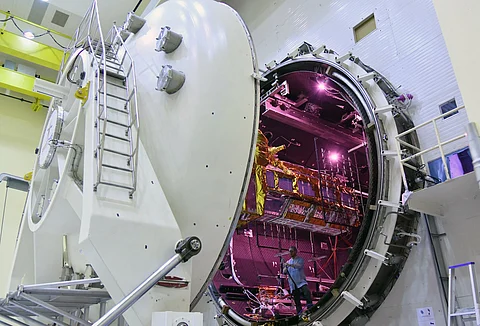

The NASA-ISRO Synthetic Aperture Radar (NISAR) satellite has successfully completed a 21-day trial to assess its performance under conditions it could encounter in space. The trial, conducted from October 19 to November 13, 2023, within a vacuum chamber at the ISRO Satellite Integration and Test Establishment (ISITE) in Bengaluru, was a complete success, it has been stated. This facility, part of the UR Rao Satellite Centre (URSC), is where ISRO assembles and tests its spacecraft before launch.
ISRO and NASA's Jet Propulsion Laboratory collaborated in the trial, aimed at conducting continuous assessments of the satellite's thermal systems and its two main scientific instrument systems – the L-band and S-band radars. These evaluations were carried out under the most extreme temperature conditions that the satellite was anticipated to encounter in space.
The US Consulate General Chennai facilitated a NASA Jet Propulsion Laboratory (JPL) media roundtable moderated by American diplomat and spokesperson Samantha Jackson at the Leela Palace in Bengaluru. During a media briefing on Wednesday, November 14, NISAR Project Manager Phil Barela revealed that the Indian Space Research Organisation (ISRO)was targeting the first quarter of the next year for the launch. He expected the ISRO Geosynchronous Satellite Launch Vehicle Mark-II to launch NISAR after January from the Satish Dhawan Space Centre in Sriharikota. The mission, spanning three years, aims to survey the entire Earth's land and ice-covered surfaces every 12 days.
NISAR's objective is to map the entire globe in the 12-day cycle, providing consistent spatial and temporal data to understand changes in Earth's ecosystems, ice mass, vegetation biomass, sea level rise, groundwater, and natural hazards such as earthquakes, tsunamis, volcanoes, and landslides.
The project seeks to understand carbon storage and uptake dynamics in wooded, agricultural, wetland, and permafrost ecosystems.
As Telangana, Mizoram, MP, Chhattisgarh, & Rajasthan go to the polls, TNM and Newslaundry are joining forces to bring you the best on-ground reportage and analysis. Click here to support our election fund.
Laurie Leshin, Director of the Jet Propulsion Laboratory said the project would seek to investigate the response of ice sheets to climate change, the interaction of sea ice with climate, and global impacts on sea level rise. According to NASA, the onboard instruments are capable of detecting even minor changes of one centimetre from space.